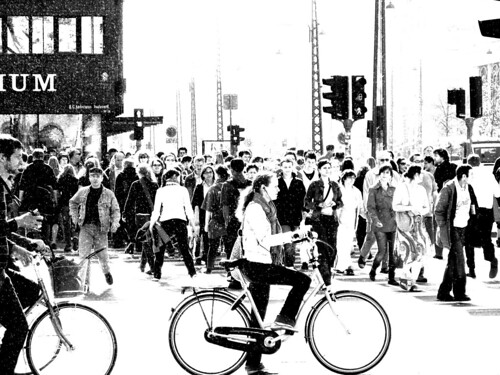

I recieved a press release from the European Cyclists Federation today. Here’s what it’s all about. The European Cyclists Federation recently co-signed a letter initiated by the European Transport Safety Council [ETSC] asking European Union Transport Commissioner Siim Kallas for renewed road safety targets in the forthcoming Road Safety Action Programme.
On 19 March, The ECF and the Federation of European Pedestrian Associations [FEPA] sent a joint follow-up to the ETSC’s letter, to highlight the importance of setting ‘rate based’ safety targets for walking and cycling.
Our request to Mr Kallas is to include a target of halving pedestrian and cyclist KSI rates by 2020, measured according to injuries and fatalities per km travelled or per trip walked or cycled.We believe this is vital for three key reasons:- The evidence on ‘safety in numbers’ shows that the more people there are cycling and walking, the safer these modes become.- The health benefits of walking and cycling far outweigh the safety risks involved.
- Pedestrians and cyclists have a very low involvement rate in injuring other road users, so shifting from motorised to active modes should improve overall road safety.Rate-based targets give a true reflection of how safe it is for the individual pedestrian or cyclist to travel by these modes, and avoid the risk of safety targets operating as a perverse incentive to discourage active travel.
In the open letter to Commissioner Kallas (.pdf download) they highlight various national examples:
- In the Netherlands between 1980 and 2005, there was a 45% increase in cycling, and a 58% reduction in cyclist fatalities. [1]- In Germany between 1975 and 1998, the proportion of trips made by cycle rose from 8 to 12%, while cyclist fatalities fell by 66%. [2]- Western Australia increased cycle use by 82% in 7 years during the 1980s, while reducing hospital admissions by 5%. [3]- In the Netherlands between the period 1985-87 and the period 2001-03, person kilometres travelled on foot increased by 24% while pedestrian fatalities per kilometre walked decreased by 58%. [4]And a couple of city examples:- In London, cycle use on the city’s main roads increased by 107% between 2000 and 2008, while cyclist KSIs fell by 21% over roughly the same period [5]- In Copenhagen between 1995 and 2006, cycling increased by 44% and the proportion of people cycling to work increased from 31% to 36%; meanwhile cyclist KSIs fell by 60% [6][1] Ministerie van Verkeer en Waterstaat. Cycling in the Netherlands 2009, p14 (.pdf)
[2] Pucher J and Dijkstra L. Making walking and cycling safer: lessons from Europe. In Transportation Quarterly vol. 54 no. 3, pp25-50, 2000 (.pdf)
[3] Robinson D. Safety in numbers in Australia: more walkers and bicyclists, safer walking and bicycling. Health Promotion Journal of Australia vol.16, pp47-51 (.pdf)
[4] SafetyNet (2009) Pedestrians & Cyclists, p.11 & 13 (.pdf)
[5] Transport for London. Mayor challenges London to get cycling. TfL press release 28th May 2009.
[6] City of Copenhagen Traffic Department. Copenhagen, city of cyclists: bicycle account 2006. Copenhagen 2007 (.pdf).





